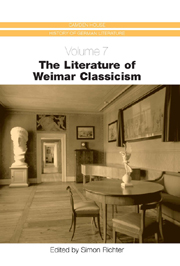Book contents
- Frontmatter
- Contents
- List of Illustrations
- Preface and Acknowledgments
- Conventions, Editions, and Abbreviations
- Introduction
- What is Classicism?
- Antiquity and Weimar Classicism
- The Correspondents' Noncorrespondence: Goethe, Schiller and the Briefwechsel
- Johann Gottfried Herder: The Weimar Classic Back of the (City)Church
- Drama and Theatrical Practice in Weimar Classicism
- German Classical Poetry
- The Novel in Weimar Classicism: Symbolic Form and Symbolic Pregnance
- German Women Writers and Classicism
- Weimar Classicism as Visual Culture
- The Irrelevance of Aesthetics and the De-Theorizing of the Self in “Classical” Weimar
- Goethe's “Classical” Science
- The Political Context of Weimar Classicism
- Bibliography
- Notes on the Contributors
- Index
Introduction
Published online by Cambridge University Press: 05 February 2013
- Frontmatter
- Contents
- List of Illustrations
- Preface and Acknowledgments
- Conventions, Editions, and Abbreviations
- Introduction
- What is Classicism?
- Antiquity and Weimar Classicism
- The Correspondents' Noncorrespondence: Goethe, Schiller and the Briefwechsel
- Johann Gottfried Herder: The Weimar Classic Back of the (City)Church
- Drama and Theatrical Practice in Weimar Classicism
- German Classical Poetry
- The Novel in Weimar Classicism: Symbolic Form and Symbolic Pregnance
- German Women Writers and Classicism
- Weimar Classicism as Visual Culture
- The Irrelevance of Aesthetics and the De-Theorizing of the Self in “Classical” Weimar
- Goethe's “Classical” Science
- The Political Context of Weimar Classicism
- Bibliography
- Notes on the Contributors
- Index
Summary
If literary historians agree on anything, it is that Weimar Classicism as a distinct literary period ought not to exist. And of course they are right. Literary periodization is heuristic and even arbitrary under the best of circumstances. But to assert that the efforts of two men, Johann Wolfgang von Goethe (1749–1832) and Friedrich Schiller (1759–1805), from the time of the former's eye-opening journey to Italy in 1786 to the death of the latter in 1805, constitute a literary period in its own right seems excessive. Not only is the membership of the putative period so small (we could and will add lesser known names to the list) and so local (confined to those residing or sojourning in the small duchy of Saxe-Weimar, or wishing they did), the major problem, as many critics have shown, is that the characteristics of Weimar Classicism are perfectly consistent with those of European Romanticism, a bona fide literary period that easily embraces the phenomenon under discussion. Indeed, as twentieth-century scholars have never tired of pointing out, from the perspective of English and French literary history, Goethe and Schiller are among Germany's premiere Romantic writers. Only nineteenth-century German nationalism thought to exalt them to the level of the classical. Even Goethe himself can readily be enlisted in the effort to debunk the myth of Weimar Classicism.
- Type
- Chapter
- Information
- The Literature of Weimar Classicism , pp. 3 - 44Publisher: Boydell & BrewerPrint publication year: 2005



